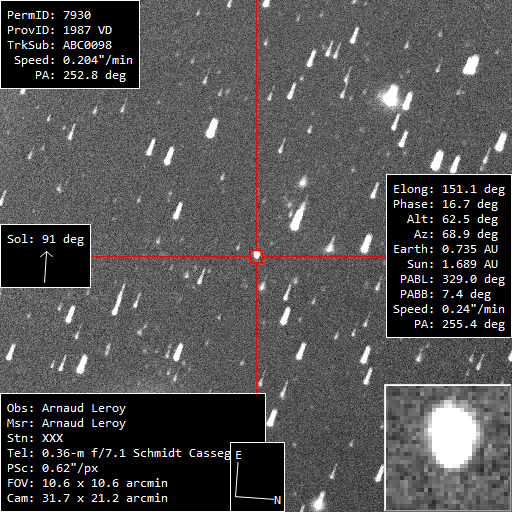Depuis de nombreuses années , la découverte d’astéroïdes double ou ayant un petit satellite devient finalement courant. On estime qu’à l’heure actuelle, il y a au moins 30% des astéroïdes qui sont doubles voir triples. Dans ce cadre , à l’observatoire de Besely près de Mahajunga à Madagascar, nous avons participé à ce type de découvertes. Sur les mois de juillet, août et septembre, nous avons observé sur plusieurs nuits , trois astéroïdes candidats. Ce programme est dirigé par un chercheur tchèque, Petr Pravec de l’observatoire d’Ondrejov (33km du centre de Prague).

Détection d’un des astéroides
Les observations ont consisté à prendre des images à intervalle régulier (typiquement des poses unitaires de 5min) sur ces objets. En analysant, la variation de luminosité de l’astéroïde au cours de la session d’observation, on en obtient une courbe de lumière qui nous donne la période de rotation de l’objet concerné. C’est dans ces courbes de lumière que nous cherchons des petites variations qui trahissent la présence du satellite. Les données produites doivent permettent d’obtenir une incertitude sur les mesures de magnitude de quelques centièmes. Nous en reproduisons un exemple ici. Bien entendu, ces résultats sont obtenus avec la collaboration de plusieurs observatoires , qu’ils soient amateurs ou professionnels.

Variation de la magnitude de l’astéroide
Arnaud Leroy, Uranoscope de l’Ile de France
Les circulaires annonçant les découvertes :
2024 September 17 (CBET 5449) Daniel W. E. Green » [2024-09-18 05:53, Ondrejov]
2024 September 15 (CBET 5446) Daniel W. E. Green » [2024-09-16 06:07, Ondrejov]
